Taxation Law Assignment: Capital Gains and Fringe Benefits
VerifiedAdded on 2019/10/31
|8
|1476
|247
Homework Assignment
AI Summary
This document presents a comprehensive solution to a taxation assignment, addressing various aspects of Australian tax law. The assignment covers the computation of taxable amounts for capital gains transactions, considering assets like shares, antique items, and home sound systems. It delves i...

Taxation
Paraphrase This Document
Need a fresh take? Get an instant paraphrase of this document with our AI Paraphraser
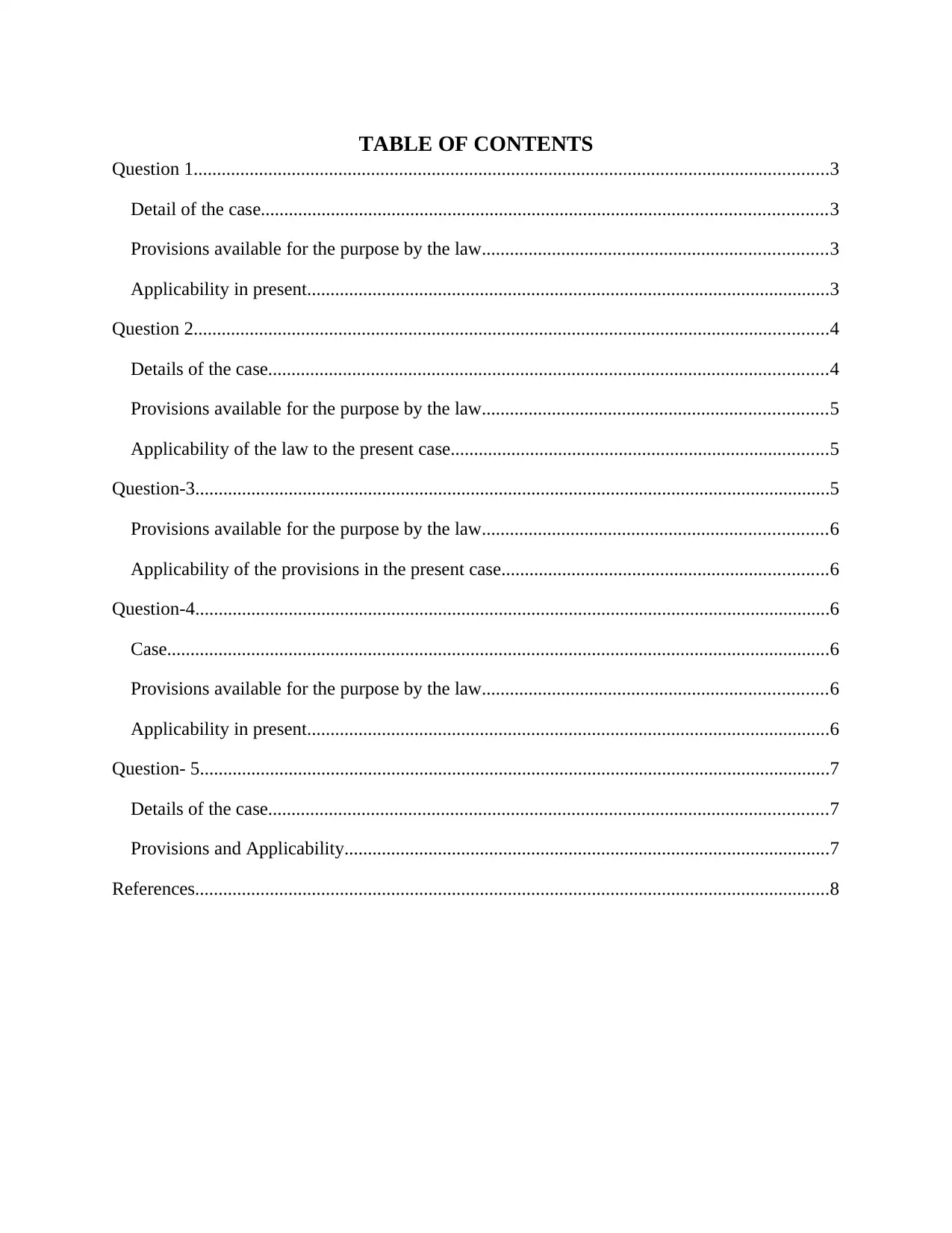
TABLE OF CONTENTS
Question 1........................................................................................................................................3
Detail of the case.........................................................................................................................3
Provisions available for the purpose by the law..........................................................................3
Applicability in present................................................................................................................3
Question 2........................................................................................................................................4
Details of the case........................................................................................................................4
Provisions available for the purpose by the law..........................................................................5
Applicability of the law to the present case.................................................................................5
Question-3........................................................................................................................................5
Provisions available for the purpose by the law..........................................................................6
Applicability of the provisions in the present case......................................................................6
Question-4........................................................................................................................................6
Case..............................................................................................................................................6
Provisions available for the purpose by the law..........................................................................6
Applicability in present................................................................................................................6
Question- 5.......................................................................................................................................7
Details of the case........................................................................................................................7
Provisions and Applicability........................................................................................................7
References........................................................................................................................................8
Question 1........................................................................................................................................3
Detail of the case.........................................................................................................................3
Provisions available for the purpose by the law..........................................................................3
Applicability in present................................................................................................................3
Question 2........................................................................................................................................4
Details of the case........................................................................................................................4
Provisions available for the purpose by the law..........................................................................5
Applicability of the law to the present case.................................................................................5
Question-3........................................................................................................................................5
Provisions available for the purpose by the law..........................................................................6
Applicability of the provisions in the present case......................................................................6
Question-4........................................................................................................................................6
Case..............................................................................................................................................6
Provisions available for the purpose by the law..........................................................................6
Applicability in present................................................................................................................6
Question- 5.......................................................................................................................................7
Details of the case........................................................................................................................7
Provisions and Applicability........................................................................................................7
References........................................................................................................................................8
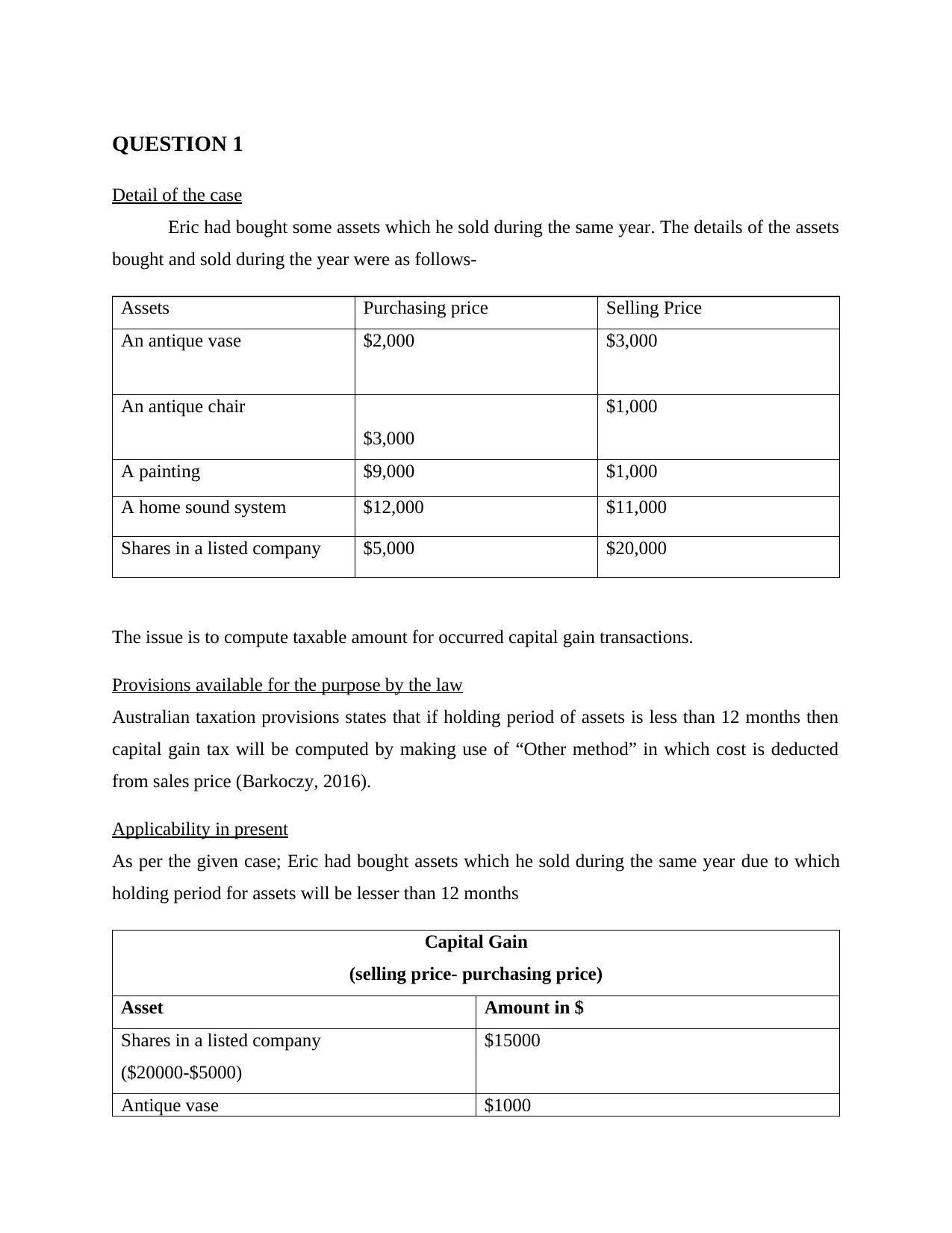
QUESTION 1
Detail of the case
Eric had bought some assets which he sold during the same year. The details of the assets
bought and sold during the year were as follows-
Assets Purchasing price Selling Price
An antique vase $2,000 $3,000
An antique chair
$3,000
$1,000
A painting $9,000 $1,000
A home sound system $12,000 $11,000
Shares in a listed company $5,000 $20,000
The issue is to compute taxable amount for occurred capital gain transactions.
Provisions available for the purpose by the law
Australian taxation provisions states that if holding period of assets is less than 12 months then
capital gain tax will be computed by making use of “Other method” in which cost is deducted
from sales price (Barkoczy, 2016).
Applicability in present
As per the given case; Eric had bought assets which he sold during the same year due to which
holding period for assets will be lesser than 12 months
Capital Gain
(selling price- purchasing price)
Asset Amount in $
Shares in a listed company
($20000-$5000)
$15000
Antique vase $1000
Detail of the case
Eric had bought some assets which he sold during the same year. The details of the assets
bought and sold during the year were as follows-
Assets Purchasing price Selling Price
An antique vase $2,000 $3,000
An antique chair
$3,000
$1,000
A painting $9,000 $1,000
A home sound system $12,000 $11,000
Shares in a listed company $5,000 $20,000
The issue is to compute taxable amount for occurred capital gain transactions.
Provisions available for the purpose by the law
Australian taxation provisions states that if holding period of assets is less than 12 months then
capital gain tax will be computed by making use of “Other method” in which cost is deducted
from sales price (Barkoczy, 2016).
Applicability in present
As per the given case; Eric had bought assets which he sold during the same year due to which
holding period for assets will be lesser than 12 months
Capital Gain
(selling price- purchasing price)
Asset Amount in $
Shares in a listed company
($20000-$5000)
$15000
Antique vase $1000
⊘ This is a preview!⊘
Do you want full access?
Subscribe today to unlock all pages.

Trusted by 1+ million students worldwide
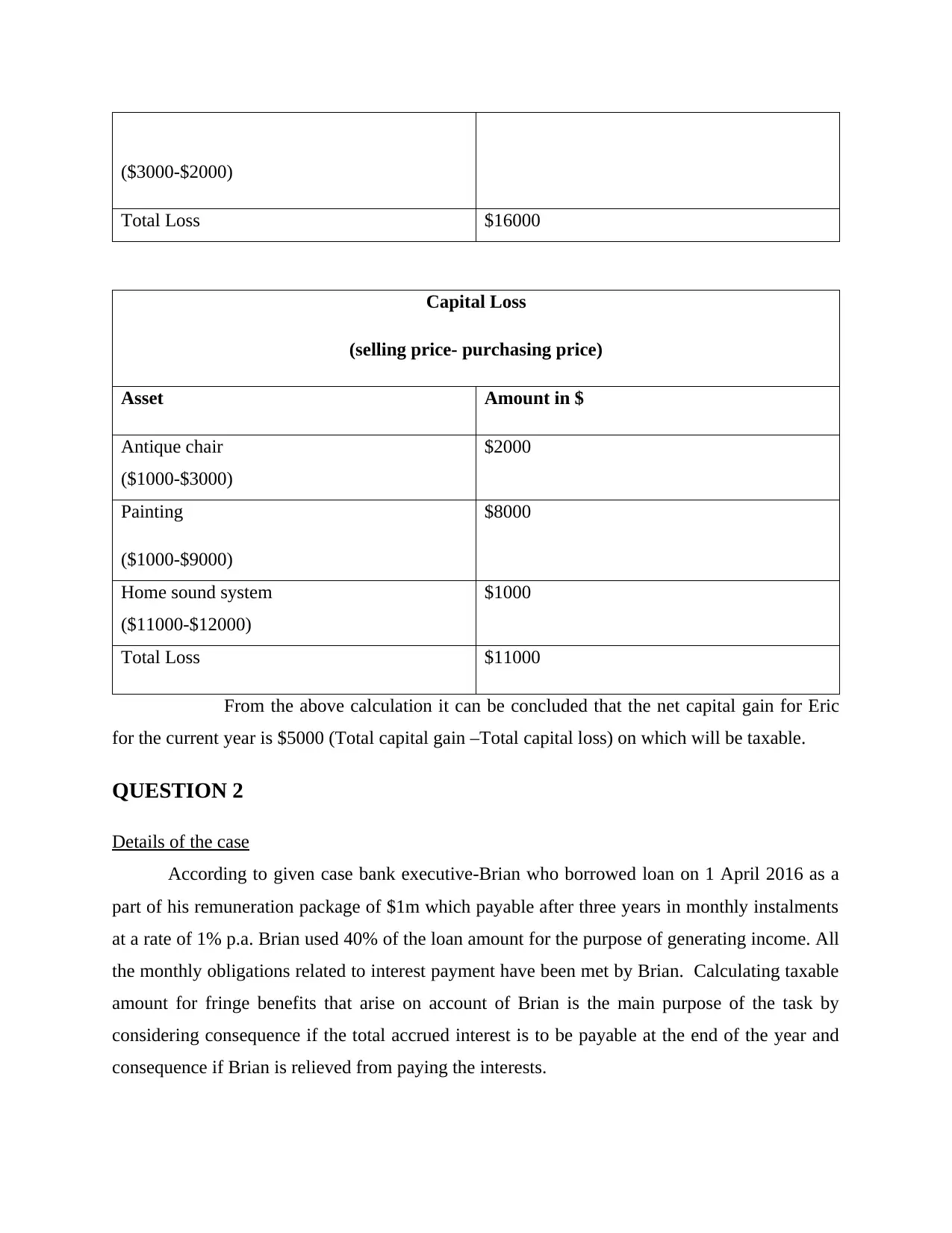
($3000-$2000)
Total Loss $16000
Capital Loss
(selling price- purchasing price)
Asset Amount in $
Antique chair
($1000-$3000)
$2000
Painting
($1000-$9000)
$8000
Home sound system
($11000-$12000)
$1000
Total Loss $11000
From the above calculation it can be concluded that the net capital gain for Eric
for the current year is $5000 (Total capital gain –Total capital loss) on which will be taxable.
QUESTION 2
Details of the case
According to given case bank executive-Brian who borrowed loan on 1 April 2016 as a
part of his remuneration package of $1m which payable after three years in monthly instalments
at a rate of 1% p.a. Brian used 40% of the loan amount for the purpose of generating income. All
the monthly obligations related to interest payment have been met by Brian. Calculating taxable
amount for fringe benefits that arise on account of Brian is the main purpose of the task by
considering consequence if the total accrued interest is to be payable at the end of the year and
consequence if Brian is relieved from paying the interests.
Total Loss $16000
Capital Loss
(selling price- purchasing price)
Asset Amount in $
Antique chair
($1000-$3000)
$2000
Painting
($1000-$9000)
$8000
Home sound system
($11000-$12000)
$1000
Total Loss $11000
From the above calculation it can be concluded that the net capital gain for Eric
for the current year is $5000 (Total capital gain –Total capital loss) on which will be taxable.
QUESTION 2
Details of the case
According to given case bank executive-Brian who borrowed loan on 1 April 2016 as a
part of his remuneration package of $1m which payable after three years in monthly instalments
at a rate of 1% p.a. Brian used 40% of the loan amount for the purpose of generating income. All
the monthly obligations related to interest payment have been met by Brian. Calculating taxable
amount for fringe benefits that arise on account of Brian is the main purpose of the task by
considering consequence if the total accrued interest is to be payable at the end of the year and
consequence if Brian is relieved from paying the interests.
Paraphrase This Document
Need a fresh take? Get an instant paraphrase of this document with our AI Paraphraser
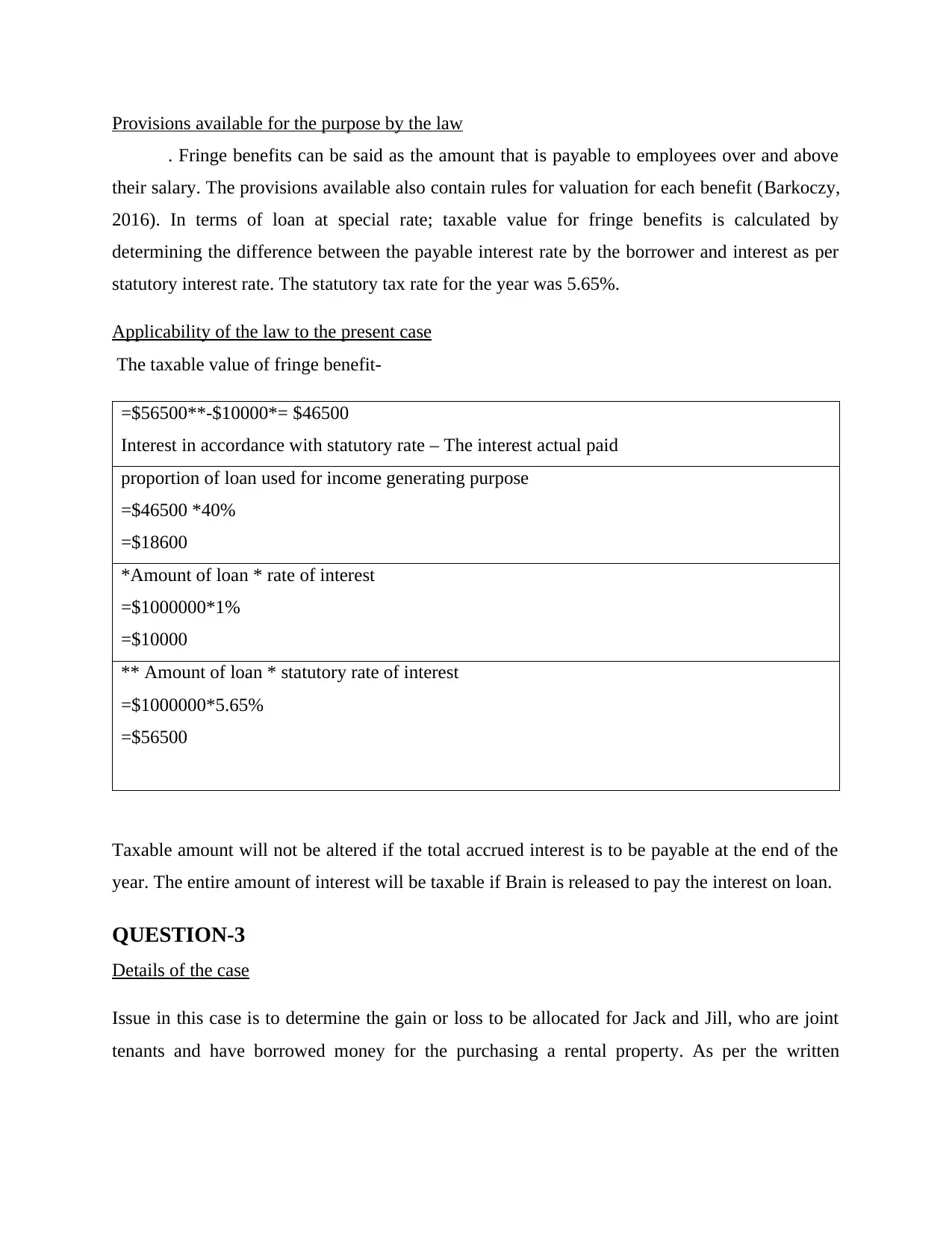
Provisions available for the purpose by the law
. Fringe benefits can be said as the amount that is payable to employees over and above
their salary. The provisions available also contain rules for valuation for each benefit (Barkoczy,
2016). In terms of loan at special rate; taxable value for fringe benefits is calculated by
determining the difference between the payable interest rate by the borrower and interest as per
statutory interest rate. The statutory tax rate for the year was 5.65%.
Applicability of the law to the present case
The taxable value of fringe benefit-
=$56500**-$10000*= $46500
Interest in accordance with statutory rate – The interest actual paid
proportion of loan used for income generating purpose
=$46500 *40%
=$18600
*Amount of loan * rate of interest
=$1000000*1%
=$10000
** Amount of loan * statutory rate of interest
=$1000000*5.65%
=$56500
Taxable amount will not be altered if the total accrued interest is to be payable at the end of the
year. The entire amount of interest will be taxable if Brain is released to pay the interest on loan.
QUESTION-3
Details of the case
Issue in this case is to determine the gain or loss to be allocated for Jack and Jill, who are joint
tenants and have borrowed money for the purchasing a rental property. As per the written
. Fringe benefits can be said as the amount that is payable to employees over and above
their salary. The provisions available also contain rules for valuation for each benefit (Barkoczy,
2016). In terms of loan at special rate; taxable value for fringe benefits is calculated by
determining the difference between the payable interest rate by the borrower and interest as per
statutory interest rate. The statutory tax rate for the year was 5.65%.
Applicability of the law to the present case
The taxable value of fringe benefit-
=$56500**-$10000*= $46500
Interest in accordance with statutory rate – The interest actual paid
proportion of loan used for income generating purpose
=$46500 *40%
=$18600
*Amount of loan * rate of interest
=$1000000*1%
=$10000
** Amount of loan * statutory rate of interest
=$1000000*5.65%
=$56500
Taxable amount will not be altered if the total accrued interest is to be payable at the end of the
year. The entire amount of interest will be taxable if Brain is released to pay the interest on loan.
QUESTION-3
Details of the case
Issue in this case is to determine the gain or loss to be allocated for Jack and Jill, who are joint
tenants and have borrowed money for the purchasing a rental property. As per the written
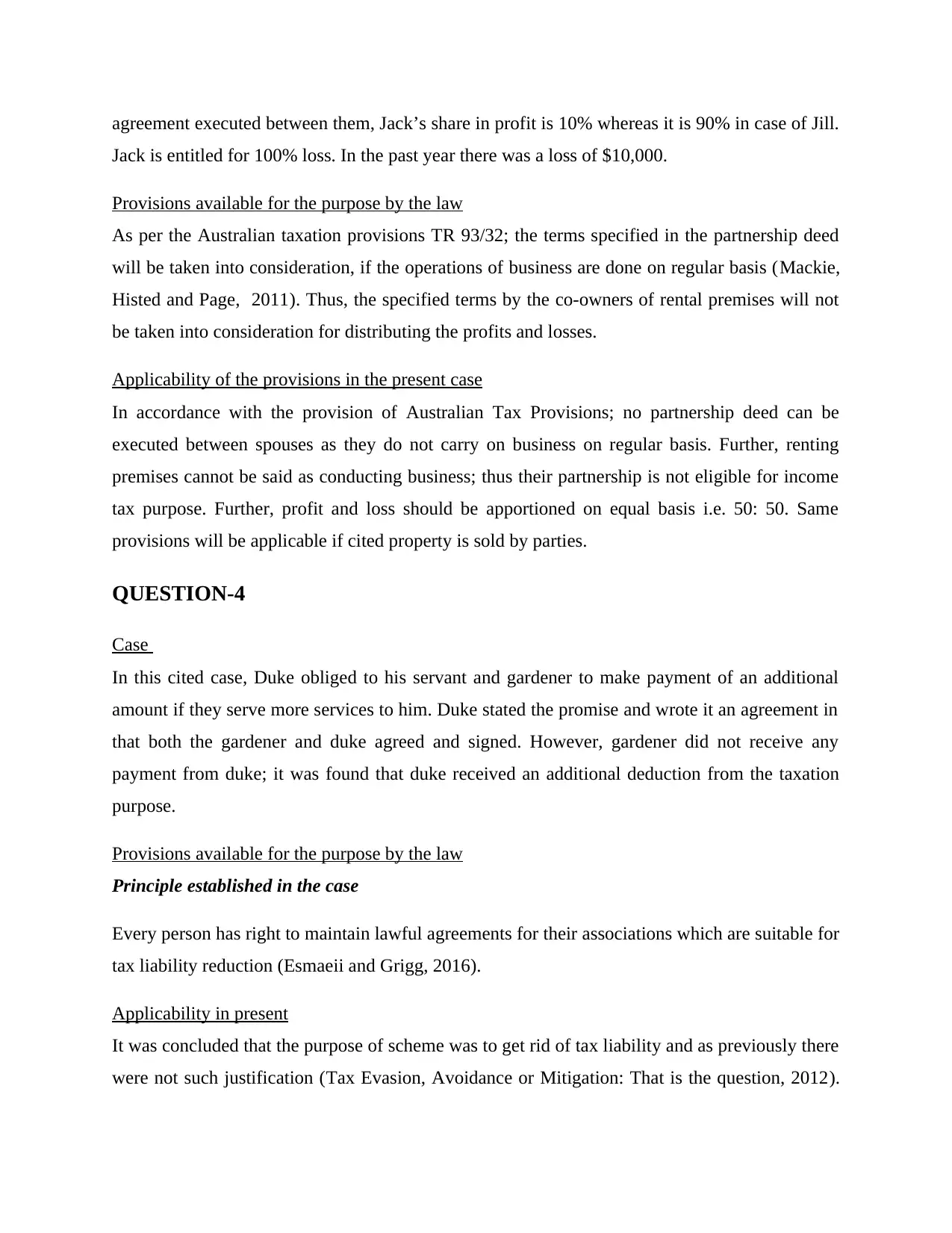
agreement executed between them, Jack’s share in profit is 10% whereas it is 90% in case of Jill.
Jack is entitled for 100% loss. In the past year there was a loss of $10,000.
Provisions available for the purpose by the law
As per the Australian taxation provisions TR 93/32; the terms specified in the partnership deed
will be taken into consideration, if the operations of business are done on regular basis (Mackie,
Histed and Page, 2011). Thus, the specified terms by the co-owners of rental premises will not
be taken into consideration for distributing the profits and losses.
Applicability of the provisions in the present case
In accordance with the provision of Australian Tax Provisions; no partnership deed can be
executed between spouses as they do not carry on business on regular basis. Further, renting
premises cannot be said as conducting business; thus their partnership is not eligible for income
tax purpose. Further, profit and loss should be apportioned on equal basis i.e. 50: 50. Same
provisions will be applicable if cited property is sold by parties.
QUESTION-4
Case
In this cited case, Duke obliged to his servant and gardener to make payment of an additional
amount if they serve more services to him. Duke stated the promise and wrote it an agreement in
that both the gardener and duke agreed and signed. However, gardener did not receive any
payment from duke; it was found that duke received an additional deduction from the taxation
purpose.
Provisions available for the purpose by the law
Principle established in the case
Every person has right to maintain lawful agreements for their associations which are suitable for
tax liability reduction (Esmaeii and Grigg, 2016).
Applicability in present
It was concluded that the purpose of scheme was to get rid of tax liability and as previously there
were not such justification (Tax Evasion, Avoidance or Mitigation: That is the question, 2012).
Jack is entitled for 100% loss. In the past year there was a loss of $10,000.
Provisions available for the purpose by the law
As per the Australian taxation provisions TR 93/32; the terms specified in the partnership deed
will be taken into consideration, if the operations of business are done on regular basis (Mackie,
Histed and Page, 2011). Thus, the specified terms by the co-owners of rental premises will not
be taken into consideration for distributing the profits and losses.
Applicability of the provisions in the present case
In accordance with the provision of Australian Tax Provisions; no partnership deed can be
executed between spouses as they do not carry on business on regular basis. Further, renting
premises cannot be said as conducting business; thus their partnership is not eligible for income
tax purpose. Further, profit and loss should be apportioned on equal basis i.e. 50: 50. Same
provisions will be applicable if cited property is sold by parties.
QUESTION-4
Case
In this cited case, Duke obliged to his servant and gardener to make payment of an additional
amount if they serve more services to him. Duke stated the promise and wrote it an agreement in
that both the gardener and duke agreed and signed. However, gardener did not receive any
payment from duke; it was found that duke received an additional deduction from the taxation
purpose.
Provisions available for the purpose by the law
Principle established in the case
Every person has right to maintain lawful agreements for their associations which are suitable for
tax liability reduction (Esmaeii and Grigg, 2016).
Applicability in present
It was concluded that the purpose of scheme was to get rid of tax liability and as previously there
were not such justification (Tax Evasion, Avoidance or Mitigation: That is the question, 2012).
⊘ This is a preview!⊘
Do you want full access?
Subscribe today to unlock all pages.

Trusted by 1+ million students worldwide
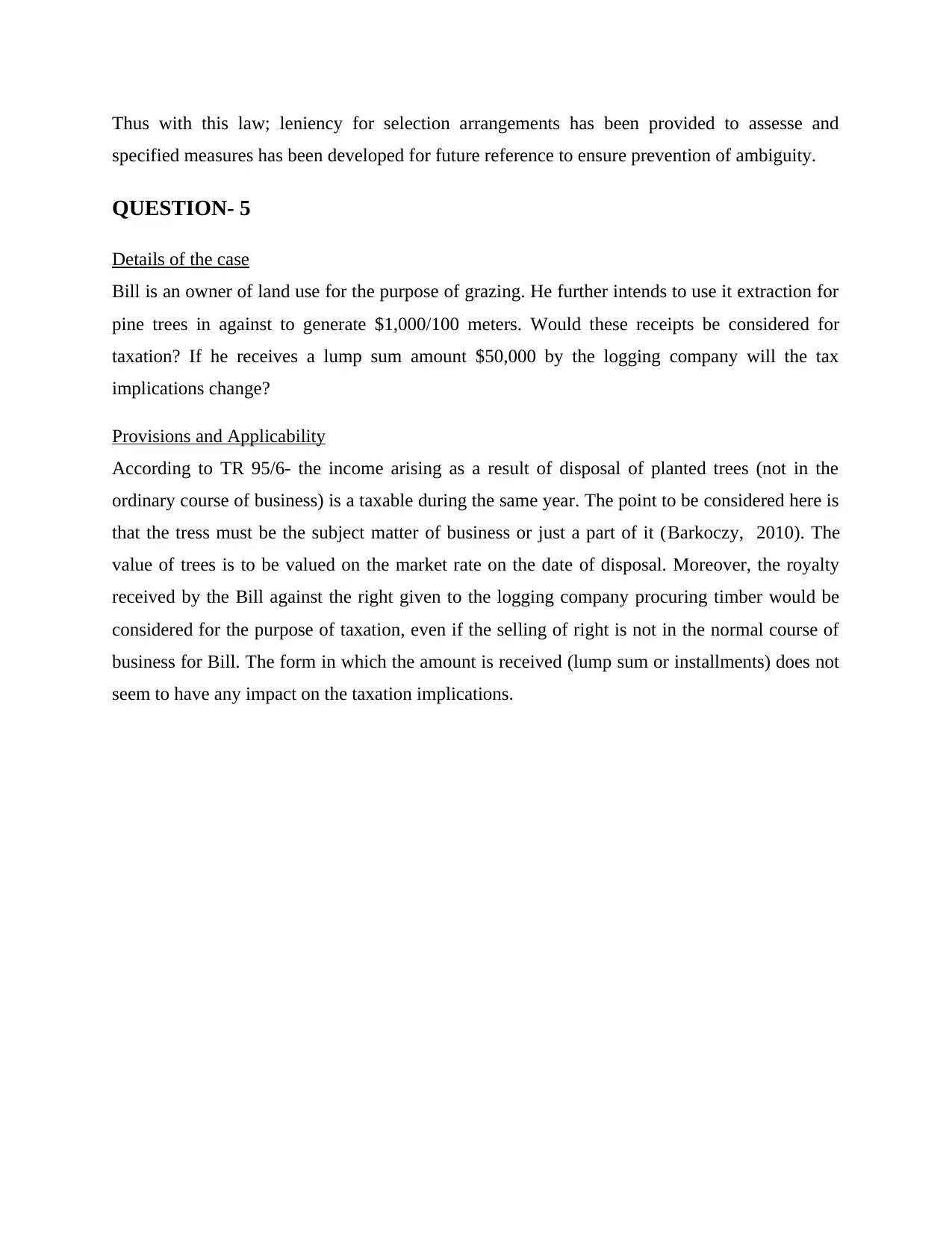
Thus with this law; leniency for selection arrangements has been provided to assesse and
specified measures has been developed for future reference to ensure prevention of ambiguity.
QUESTION- 5
Details of the case
Bill is an owner of land use for the purpose of grazing. He further intends to use it extraction for
pine trees in against to generate $1,000/100 meters. Would these receipts be considered for
taxation? If he receives a lump sum amount $50,000 by the logging company will the tax
implications change?
Provisions and Applicability
According to TR 95/6- the income arising as a result of disposal of planted trees (not in the
ordinary course of business) is a taxable during the same year. The point to be considered here is
that the tress must be the subject matter of business or just a part of it (Barkoczy, 2010). The
value of trees is to be valued on the market rate on the date of disposal. Moreover, the royalty
received by the Bill against the right given to the logging company procuring timber would be
considered for the purpose of taxation, even if the selling of right is not in the normal course of
business for Bill. The form in which the amount is received (lump sum or installments) does not
seem to have any impact on the taxation implications.
specified measures has been developed for future reference to ensure prevention of ambiguity.
QUESTION- 5
Details of the case
Bill is an owner of land use for the purpose of grazing. He further intends to use it extraction for
pine trees in against to generate $1,000/100 meters. Would these receipts be considered for
taxation? If he receives a lump sum amount $50,000 by the logging company will the tax
implications change?
Provisions and Applicability
According to TR 95/6- the income arising as a result of disposal of planted trees (not in the
ordinary course of business) is a taxable during the same year. The point to be considered here is
that the tress must be the subject matter of business or just a part of it (Barkoczy, 2010). The
value of trees is to be valued on the market rate on the date of disposal. Moreover, the royalty
received by the Bill against the right given to the logging company procuring timber would be
considered for the purpose of taxation, even if the selling of right is not in the normal course of
business for Bill. The form in which the amount is received (lump sum or installments) does not
seem to have any impact on the taxation implications.
Paraphrase This Document
Need a fresh take? Get an instant paraphrase of this document with our AI Paraphraser
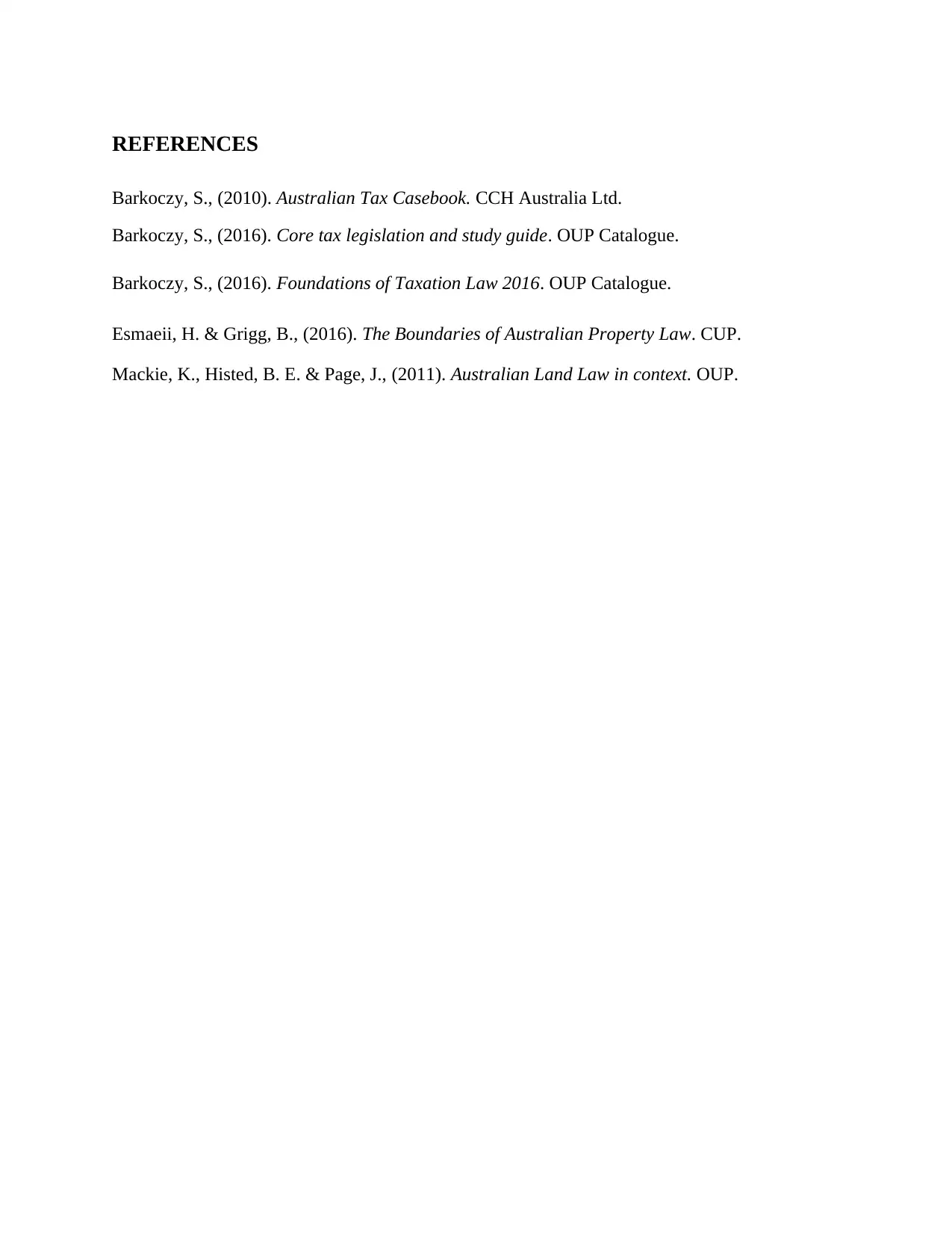
REFERENCES
Barkoczy, S., (2010). Australian Tax Casebook. CCH Australia Ltd.
Barkoczy, S., (2016). Core tax legislation and study guide. OUP Catalogue.
Barkoczy, S., (2016). Foundations of Taxation Law 2016. OUP Catalogue.
Esmaeii, H. & Grigg, B., (2016). The Boundaries of Australian Property Law. CUP.
Mackie, K., Histed, B. E. & Page, J., (2011). Australian Land Law in context. OUP.
Barkoczy, S., (2010). Australian Tax Casebook. CCH Australia Ltd.
Barkoczy, S., (2016). Core tax legislation and study guide. OUP Catalogue.
Barkoczy, S., (2016). Foundations of Taxation Law 2016. OUP Catalogue.
Esmaeii, H. & Grigg, B., (2016). The Boundaries of Australian Property Law. CUP.
Mackie, K., Histed, B. E. & Page, J., (2011). Australian Land Law in context. OUP.
1 out of 8
Related Documents
Your All-in-One AI-Powered Toolkit for Academic Success.
+13062052269
info@desklib.com
Available 24*7 on WhatsApp / Email
![[object Object]](/_next/static/media/star-bottom.7253800d.svg)
Unlock your academic potential
© 2024 | Zucol Services PVT LTD | All rights reserved.





